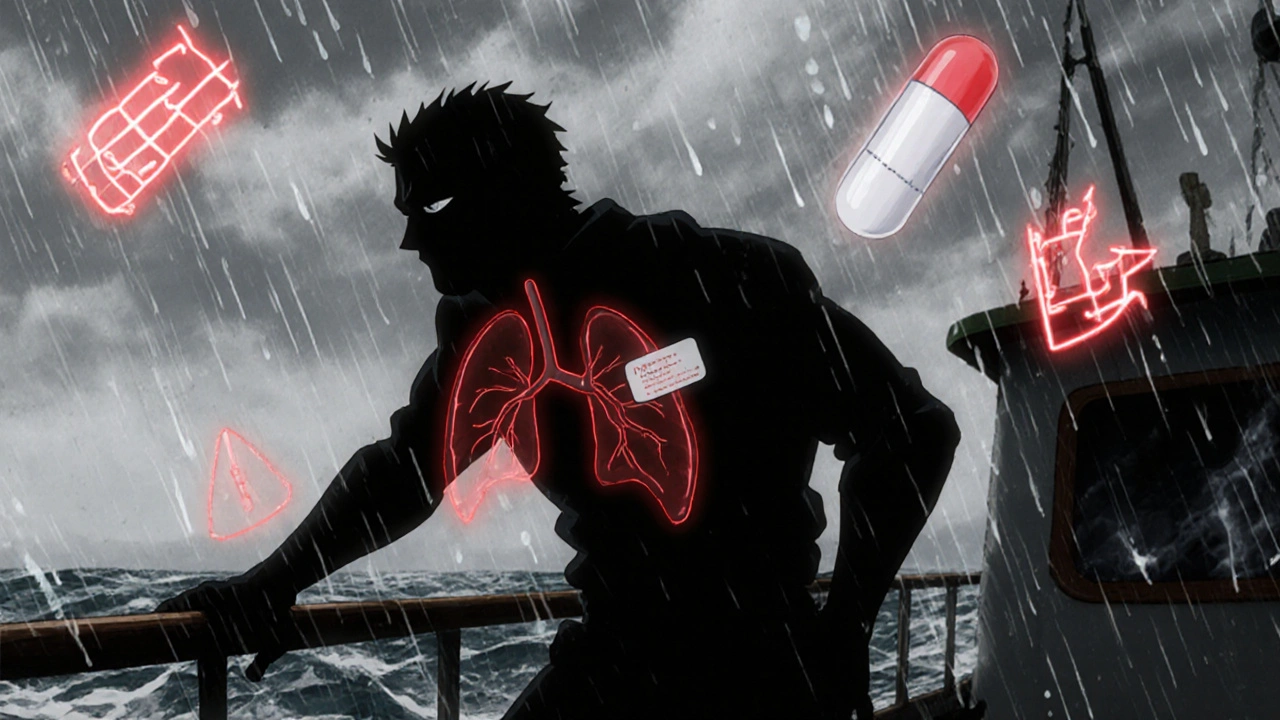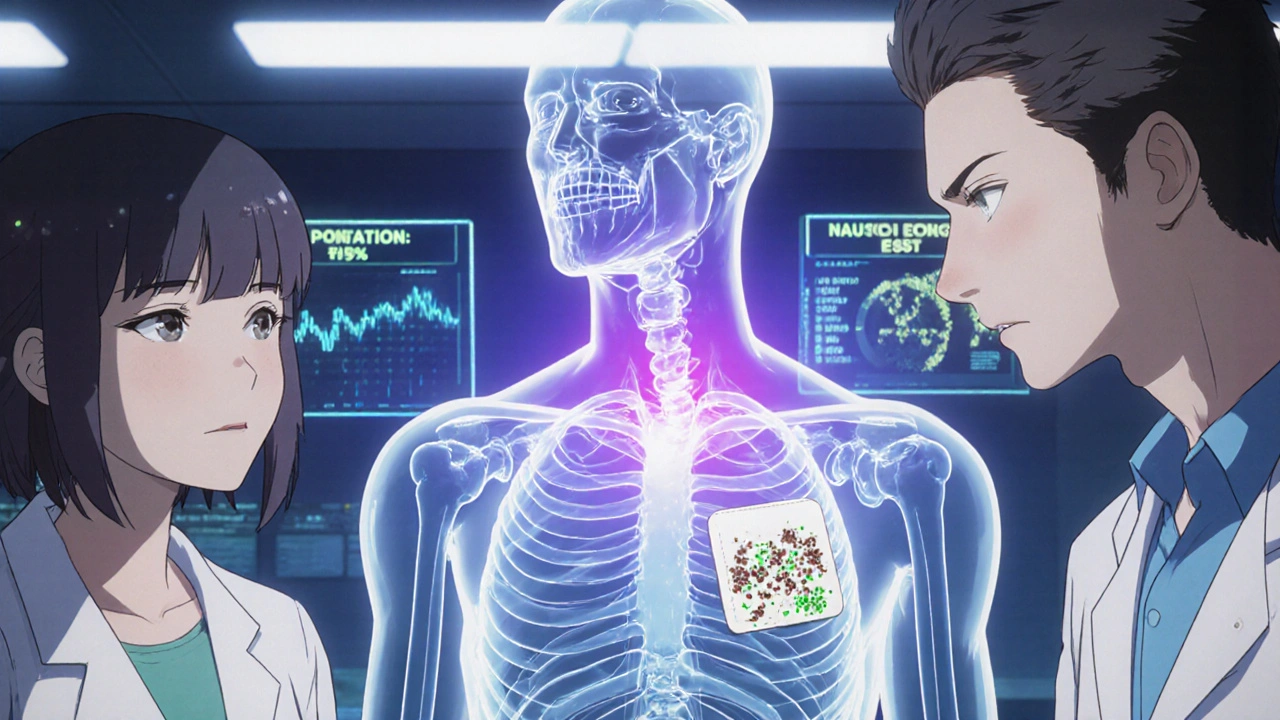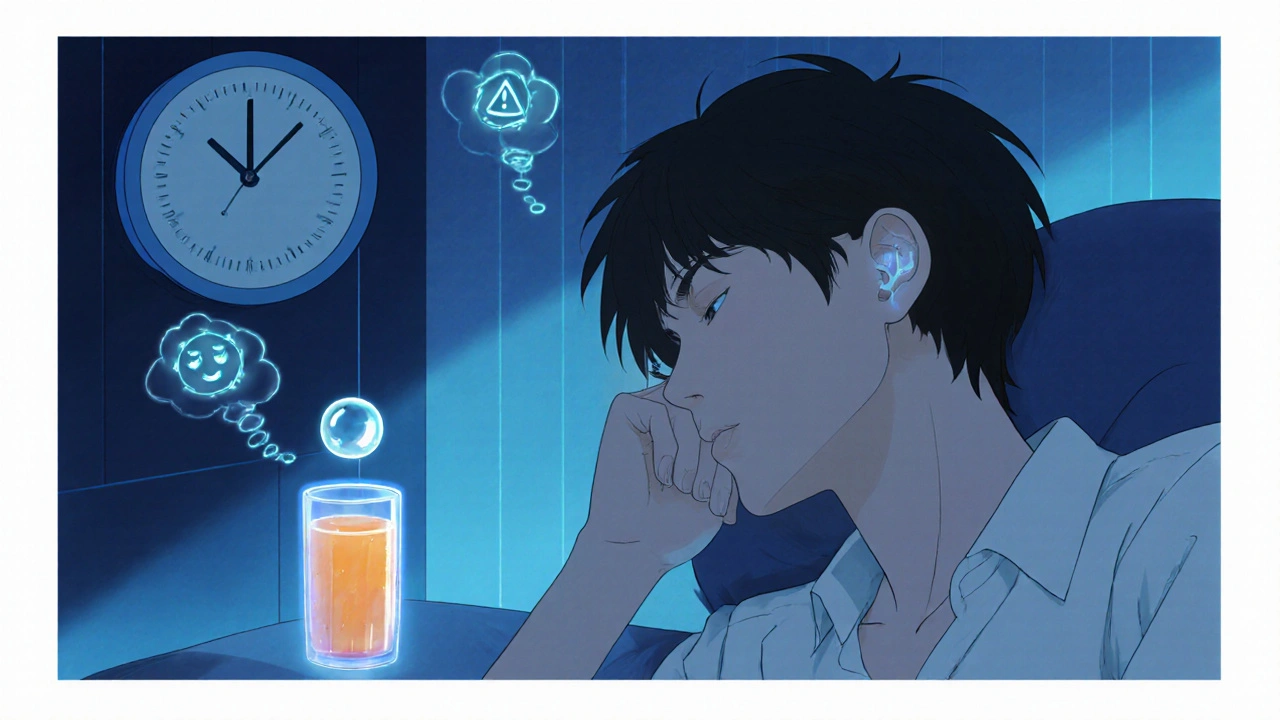When you’re on a boat, in a car, or flying through turbulence, motion sickness can hit hard. For many, the go-to solution is the scopolamine patch - a small, discreet square placed behind the ear that works for up to three days. It’s the most effective single drug for preventing motion sickness, according to medical guidelines. But here’s what no one tells you upfront: scopolamine doesn’t just stop nausea. It also makes you sleepy. And when you mix it with other common sedatives, the results can be dangerous.
How Scopolamine Actually Works
Scopolamine, also called hyoscine, blocks acetylcholine - a chemical in your brain and body that helps control movement, digestion, and alertness. By doing this, it reduces the signals that trigger nausea and vomiting during motion. But because it crosses the blood-brain barrier easily, it doesn’t just calm your stomach. It also slows down your central nervous system.
The transdermal patch (Transderm Scōp) is the most common form. It delivers about 0.5 mg of scopolamine per day, slowly releasing it into your bloodstream. Effects start around 4 hours after application and last up to 72 hours. That’s why it’s popular for long trips - cruises, road trips over 10 hours, or even military flight training. Unlike oral meds like Dramamine or Bonine, which wear off in 4-8 hours, the patch keeps working without you having to remember a second dose.
But that long-lasting effect is also its biggest risk. Once the patch is on, you can’t turn it off. If you feel too drowsy, you have to wait for it to wear off naturally - or remove it. And removal doesn’t mean instant recovery. The drug stays in your system for up to 24 hours after removal.
Why Sedatives Are a Problem
Scopolamine isn’t just a sedative - it’s a powerful one. Clinical studies show that 45% of users report noticeable drowsiness. Another 67% get dry mouth, and 32% experience blurred vision. These aren’t rare side effects. They’re expected.
Now imagine adding something else that makes you sleepy - alcohol, benzodiazepines like Xanax or Valium, opioids like oxycodone, or even over-the-counter sleep aids like diphenhydramine (Benadryl). The sedation doesn’t just add up. It multiplies.
Research from the American Society of Anesthesiologists shows that elderly patients who take scopolamine with benzodiazepines have a 40% higher chance of developing delirium. In rodent studies, combining scopolamine with sedatives increased the risk of respiratory depression by 3.2 times. That’s not theoretical. People have ended up in emergency rooms because they had one drink after applying the patch.
One user on Reddit, who goes by CruiseLover87, wrote: “Worked amazingly for seasickness but knocked me out completely the first day. Had to take it off and switch to Dramamine.” That’s not an outlier. In a survey of 287 users on r/travel, 68% reported extreme drowsiness. And 41% of negative reviews specifically mentioned unexpected intoxication after drinking alcohol.
Real-World Risks You Can’t Ignore
Let’s say you’re on a cruise. You apply the patch the night before. You sleep fine. The next morning, you feel a little groggy but think you’re okay. You have a glass of orange juice with a splash of champagne at breakfast. That’s it. One drink. But scopolamine slows how your liver processes alcohol. The result? You feel drunker than you should. Your balance is off. Your reaction time drops. You might not even realize it until you stumble walking to the rail.
Or maybe you’re a commercial fisherman. You’ve used the patch for years. You take a nap during a long haul. You wake up, take a painkiller for your back, and head back out on deck. That painkiller? It’s an opioid. The combination can cause slow, shallow breathing - something you won’t notice until it’s too late.
Even CBD is now a concern. A 2024 update from the American Medical Association warns that CBD may inhibit liver enzymes that break down scopolamine, increasing sedation by 22-35%. That’s new information. Many users don’t know this. And CBD is everywhere - gummies, oils, topicals. If you’re using it for anxiety or sleep, you might be accidentally doubling your sedation risk.

Who Should Avoid Scopolamine Altogether
Scopolamine isn’t safe for everyone. It’s contraindicated if you have:
- Glaucoma (it can raise eye pressure)
- Myasthenia gravis (it worsens muscle weakness)
- Blockages in your digestive tract or urinary system
- Severe cognitive impairment or dementia
It’s also not recommended for children under 18, pregnant women (FDA Pregnancy Category C), or people over 65 without close monitoring. Older adults are more sensitive to its brain effects - confusion, hallucinations, and memory problems can happen even at standard doses.
And while some people swear by cutting the patch in half to reduce sedation, that’s off-label use. Manufacturers don’t test or approve this method. The patch isn’t designed to be split. You might get uneven dosing, or the adhesive could fail. It’s a gamble.
What to Do If You’re Already Using It
If you’re already using the patch, here’s what you need to do right now:
- Check every medication you take. That includes prescriptions, OTC sleep aids, allergy pills, and even herbal supplements. Look for any drug labeled as a CNS depressant.
- Avoid alcohol completely. Even one drink can turn mild drowsiness into dangerous disorientation.
- Don’t drive, operate machinery, or make important decisions. Your reaction time is impaired. Studies show 72% of users avoid these activities for the first 24 hours after applying the patch.
- Apply the patch the night before. The American Academy of Neurology recommends this so you experience the full sedative effect while sleeping. You’ll know how your body reacts before you’re on the road or sea.
- Keep caffeine in moderation. Some people use coffee to fight the drowsiness. But caffeine can raise your heart rate and trigger anxiety - especially when mixed with scopolamine. It’s a band-aid, not a fix.
If you feel too sleepy, remove the patch immediately. Symptoms usually improve within 12-24 hours. Don’t wait. Don’t hope it’ll wear off. Take it off.

New Options on the Horizon
Scopolamine has been the gold standard for motion sickness since the 1980s. But it’s not perfect. That’s why the FDA approved a new lower-dose patch (0.5 mg over 3 days) in April 2024 - designed to reduce sedation while keeping anti-nausea effects.
Researchers are also testing a new patch that slowly releases caffeine along with scopolamine. Early results show it can cut drowsiness by nearly half without losing effectiveness. The trial (NCT05678901) is ongoing, with results expected in late 2025.
Another promising drug, penehyclidine hydrochloride, is being studied. It targets the same receptors as scopolamine but causes 37% less sedation. It’s not available yet - but it could be the next generation of motion sickness treatment.
For now, though, scopolamine remains the most effective option. But its power comes with responsibility. You can’t treat it like a casual drug. It’s not like taking a pill before a long drive. It’s a system-wide change in how your brain and body function.
Alternatives to Consider
If you’re worried about sedation, here are other options:
- Dimenhydrinate (Dramamine): Works well, but causes drowsiness in 68% of users. Needs dosing every 4-6 hours.
- Meclizine (Bonine): Less sedating than scopolamine. Good for short trips under 8 hours. Lasts up to 24 hours.
- Ginger: Studies show it can reduce nausea. Not as strong as scopolamine, but safe and natural. Try capsules or tea.
- Acupressure wristbands: Like Sea-Bands. Evidence is mixed, but no side effects. Worth trying if you want to avoid drugs entirely.
For most people, the trade-off is simple: scopolamine gives you the best protection against vomiting - but at the cost of alertness. If you can’t afford to be drowsy - say, you’re piloting a plane, driving a truck, or managing a child on a trip - then skip it.
Final Thoughts
Scopolamine isn’t dangerous because it’s a bad drug. It’s dangerous because people treat it like one. It’s not a quick fix. It’s a powerful tool that demands respect. The patch works. But it doesn’t play nice with other sedatives. And that’s not a minor side note - it’s the biggest risk.
If you’re considering it, talk to your doctor. Tell them everything you take - even that nightly CBD gummy or the occasional glass of wine. Don’t assume it’s safe because it’s “just a patch.”
For the right person - someone on a long cruise, a research vessel, or a military mission - scopolamine is life-changing. But for the rest of us? The drowsiness might be worse than the nausea.
Can I drink alcohol while using a scopolamine patch?
No. Mixing alcohol with scopolamine significantly increases drowsiness, dizziness, and the risk of respiratory depression. Even one drink can cause severe disorientation. Users have reported blackouts and falls after combining the two. Avoid alcohol completely while wearing the patch and for at least 24 hours after removing it.
How long does scopolamine stay in your system?
The half-life of scopolamine is 4-6 hours, but its effects can last up to 72 hours due to the slow release from the patch. After removing the patch, the drug remains in your bloodstream for up to 24 hours. You may still feel drowsy or have blurred vision during this time. Do not drive or operate heavy machinery until you’re fully alert.
Is scopolamine safe for older adults?
It’s risky. People over 65 are more sensitive to scopolamine’s effects on the brain. The risk of delirium, confusion, and memory loss increases by 40% when combined with other sedatives. The American Society of Anesthesiologists advises extreme caution or avoidance in this group. If used, start with the lowest possible dose and monitor closely.
Can I cut the scopolamine patch in half to reduce side effects?
Manufacturers do not recommend cutting the patch. The drug is evenly distributed in the adhesive layer, and cutting it may lead to uneven dosing or patch failure. While some users report success with half-patches, this is off-label use with no clinical backing. It’s safer to choose a different medication or use the full patch only if necessary.
Are there newer, less sedating alternatives to scopolamine?
Yes. In April 2024, the FDA approved a lower-dose scopolamine patch (0.5 mg over 3 days) designed to reduce sedation. Research is also underway for a patch that combines scopolamine with slow-release caffeine to counteract drowsiness. Another compound, penehyclidine hydrochloride, shows promise in trials with 37% less sedation. These options aren’t widely available yet, but they represent the future of motion sickness treatment.


Let me just say this: if you're using scopolamine and still drinking, you're not just risky-you're a walking liability. I've seen ER reports. People think 'one glass of wine' is harmless. Spoiler: it's not. The patch doesn't care if you're 'just having fun.' It's a CNS depressant with a vendetta against your reflexes. Stop pretending this is like Advil.
Actually, I think the real issue here is that people treat medical devices like candy. Scopolamine isn't a party trick-it's a pharmacological sledgehammer. I'm from Ireland, and we’ve got a long history of underestimating drugs because they’re 'natural' or 'prescribed.' This isn't a suggestion. It's a warning. Read the damn label.
I used to think ginger was just for sushi. Then I got seasick on a 12-hour ferry and tried the patch. Felt like my brain had been dipped in molasses. I didn’t drive for three days. I didn’t even answer texts. The drowsiness wasn’t just 'a side effect'-it was a personality transplant. If you’re not prepared to disappear for 72 hours, don’t touch it. I now carry ginger capsules and a pair of Sea-Bands. I call it my 'Zen Travel Kit.'
Let’s be brutally honest: the FDA-approved lower-dose patch? A PR stunt. The industry doesn’t want to lose the scopolamine monopoly. They’re just rebranding the same poison with a new label. And 'caffeine-infused' patches? That’s not innovation-that’s pharmacological whiplash. You’re not fixing the problem; you’re layering two toxins and calling it a solution. Real progress would be non-sedating anticholinergics. Not caffeine cocktails.
For those of you who think 'I’m fine with one drink'-I get it. I’ve been there. I used to be the guy who popped a Benadryl before a long drive and called it 'a little help.' Then I had a friend blackout behind the wheel after combining scopolamine with a CBD gummy. He didn’t even know he was swerving. That’s the thing about this drug: it doesn’t make you feel drunk. It makes you *think* you’re fine. That’s the trap. If you’re using anything that alters your CNS, assume it’s playing hide-and-seek with your judgment. Play it safe. Always.
As an American woman who’s seen too many elderly relatives turned into confused zombies by 'just a little patch,' I’m sick of this casual disregard for brain safety. This isn't 'cool travel hack' material. This is geriatric disaster waiting to happen. And no, cutting the patch in half isn’t 'smart.' It’s reckless. You’re not a chemist. You’re not a pharmacist. Stop experimenting on yourself.
Look. I get it. You want to enjoy your cruise. You want to feel alive. But here’s the thing: scopolamine doesn’t just sedate. It erodes. It turns your awareness into a foggy memory. I’ve been on ships. I’ve seen people stumble into railings because they thought they were 'fine.' The patch doesn’t care if you’re 'used to it.' It doesn’t care if you’re 'tough.' It’s chemistry. And chemistry doesn’t negotiate. If you’re going to use it, treat it like a loaded gun. Not a snack.
So… what’s the alternative? Just sit there and puke? I mean, I get the warnings, but what if you’re a fisherman with chronic motion sickness? You can’t just quit your job because the patch makes you sleepy. Maybe the real problem isn’t the drug-it’s that we don’t have better options. And before you say 'use ginger,' try surviving a 10-day haul in the Bering Sea with a tea bag.
Interesting. I’m curious-has anyone studied the long-term neurocognitive impact of repeated scopolamine use in occupational settings? Like commercial pilots or offshore workers who use it monthly? The acute risks are documented, but what about cumulative effects on memory consolidation or executive function? The 24-hour clearance window suggests residual activity. Are we creating a silent epidemic of cognitive fog in high-risk professions? Just wondering.